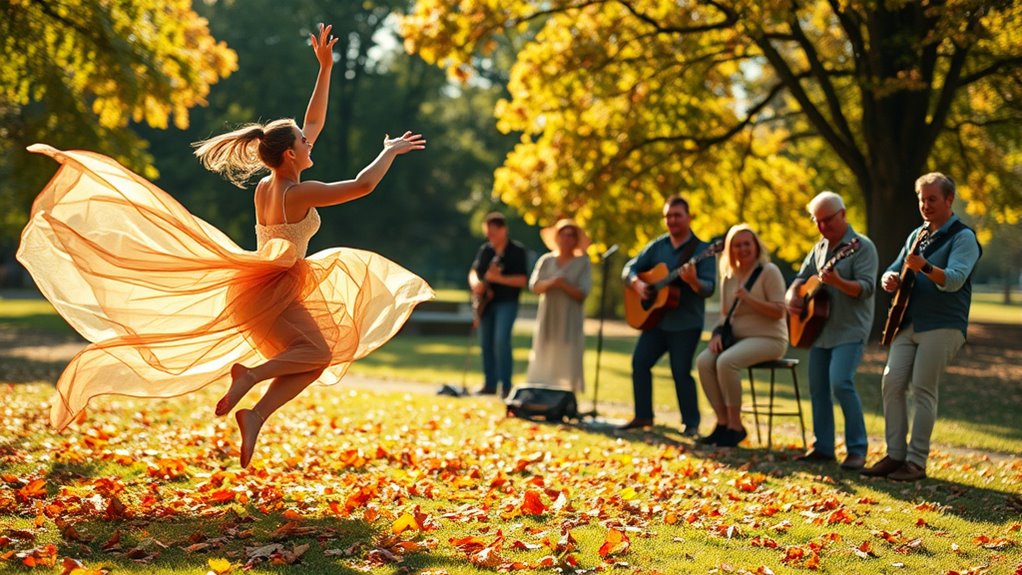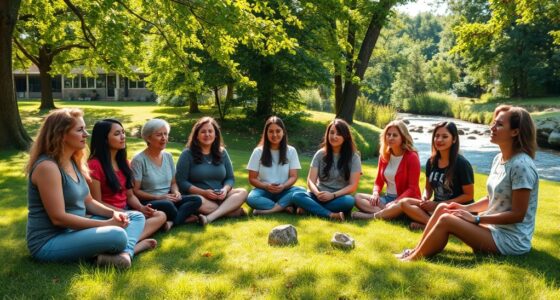Mindfulness and improvisation go hand in hand, allowing you to embrace spontaneity without judgment. By focusing on the present moment, you open yourself to creativity and authentic connections. Techniques like active listening and the “Yes, and” approach encourage collaboration and acceptance of uncertainty. As you let go of control and engage fully, you’ll find new possibilities in your experiences. Discover how these practices can transform your mindset and enhance your interactions in meaningful ways.
Key Takeaways
- Engaging in improvisation enhances mindfulness by fostering present-moment awareness and encouraging spontaneous creativity.
- The “Yes, and” principle promotes acceptance, allowing performers to take risks and embrace uncertainty.
- Regular mindfulness practices, like deep breathing, reduce performance anxiety and enhance focus during improvisation.
- Letting go of self-judgment opens opportunities for genuine interactions and authentic connections among performers.
- Embracing spontaneity encourages innovative thinking and breaks free from rigid structures, fostering a creative environment.
The Connection Between Mindfulness and Improvisation
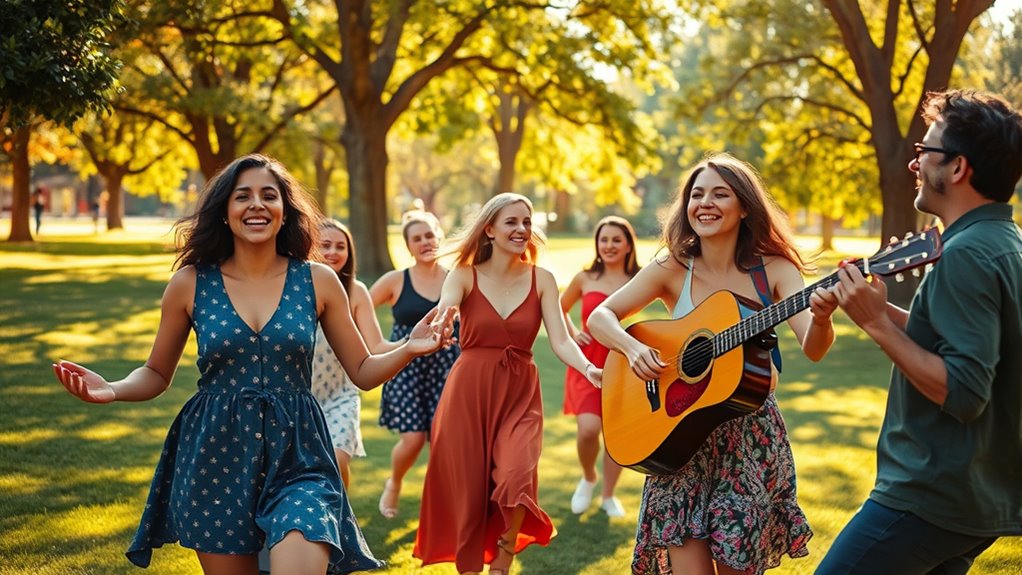
When you engage in improvisation, you tap into the essence of mindfulness by being fully present and responsive in the moment. This practice encourages you to embrace spontaneity, allowing you to explore creativity without the constraints of pre-planned ideas. Additionally, incorporating stress management techniques can further enhance your ability to remain focused and relaxed during improvisational performances. Regularly practicing effective relaxation techniques can help you manage performance anxiety and maintain a calm demeanor on stage.
By focusing on mindfulness, you learn to let go of self-judgment and preconceived notions, creating space for genuine interactions. Techniques like deep breathing help you remain grounded and engaged, enhancing your ability to respond authentically to your scene partners. The use of self-reflection techniques can also deepen your understanding of your performance and foster personal growth.
Active listening becomes essential, as it fosters collaboration and empathy, enriching the improvisational experience. Ultimately, the connection between mindfulness and improvisation cultivates a supportive environment where creativity thrives, and you can truly connect with others in your performances. Additionally, embracing failure in your improvisational journey strengthens your resilience and enhances your problem-solving skills, leading to more innovative and unique performances.
Active Listening: The Heart of Improv
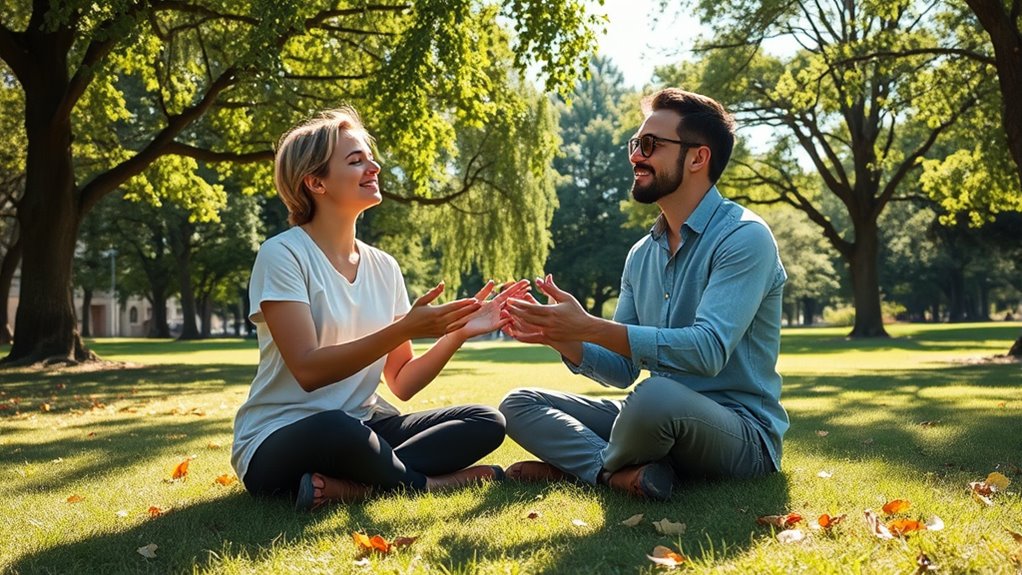
Mindfulness in improvisation naturally leads to the practice of active listening, which serves as the foundation for meaningful interactions on stage. By focusing on the present moment, you can engage fully with your scene partners, creating a collaborative nature that enhances the performance. Engaging in mindfulness can also improve your overall wellness, which supports your performance on stage. Additionally, personal development through mindfulness can enhance your ability to adapt to unexpected changes in the scene.
Mindfulness in improv fosters active listening, enabling genuine connections and collaborative performances among scene partners.
Here are some key aspects of active listening in improv:
- It helps you respond authentically to the unfolding moment.
- You elevate the narrative by making relevant contributions.
- Your focus shifts from yourself to the scene dynamics.
- Techniques like mirroring strengthen your listening skills.
- Active listening cultivates empathy and understanding among performers.
When you embrace active listening, you foster deeper connections, allowing spontaneity and creativity to thrive, enriching both your performance and the audience’s experience. Additionally, practicing mindfulness can enhance mental clarity and improve your ability to stay present during performances. Engaging in mindfulness techniques, such as deep breathing exercises, can further support your active listening skills by promoting relaxation and focus.
Embracing Uncertainty: Finding Freedom in the Unknown

Embracing uncertainty in improvisation opens the door to creativity and spontaneity. When you let go of control and suspend judgment, unexpected discoveries become possible. This practice encourages you to start anywhere, contributing without the weight of evaluation. By accepting the unknown, you can forge genuine connections and experience authentic moments. Additionally, tapping into spiritual energy can further enhance your ability to embrace spontaneity and creativity in your endeavors. Using techniques such as essential oils for relaxation can also help create a calming environment that fosters creativity. Regularly engaging in mindfulness practices can also help cultivate a mindset that embraces uncertainty and spontaneity. Furthermore, incorporating yoga techniques into your routine can enhance your ability to remain present and open to new experiences.
| Benefits of Embracing Uncertainty | Techniques to Enhance Spontaneity |
|---|---|
| Fosters creativity | Deep breathing |
| Transforms mistakes into growth | Immediate contribution |
| Encourages authentic connection | Mindfulness practices |
| Reduces fear of failure | Open mindset |
The Power of Presence in Performance

Letting go of control fosters a deeper connection with the present moment, amplifying the power of presence in performance. When you embrace the unknown, you reveal your potential for authentic expression. Active listening becomes essential, shifting your focus to your scene partners and enriching your interactions.
- Cultivates genuine connections
- Enhances responsiveness and adaptability
- Reduces performance anxiety
- Encourages collaboration through “Yes, and”
- Nurtures a creative environment
Mindfulness techniques, like deep breathing, help you stay centered, allowing for clearer thoughts and more spontaneous reactions. Additionally, the benefits of curiosity can inspire you to approach improvisation with an open mind, leading to greater creativity and enjoyment. The use of multi-functional products in beauty routines reflects the growing trend of combining efficiency and creativity in everyday practices. Incorporating water requirements for plants can also serve as a grounding practice, fostering a deeper appreciation for nurturing life around you. The incorporation of essential oils can further enhance the overall experience by promoting relaxation and reducing stress.
Creativity Through Spontaneity
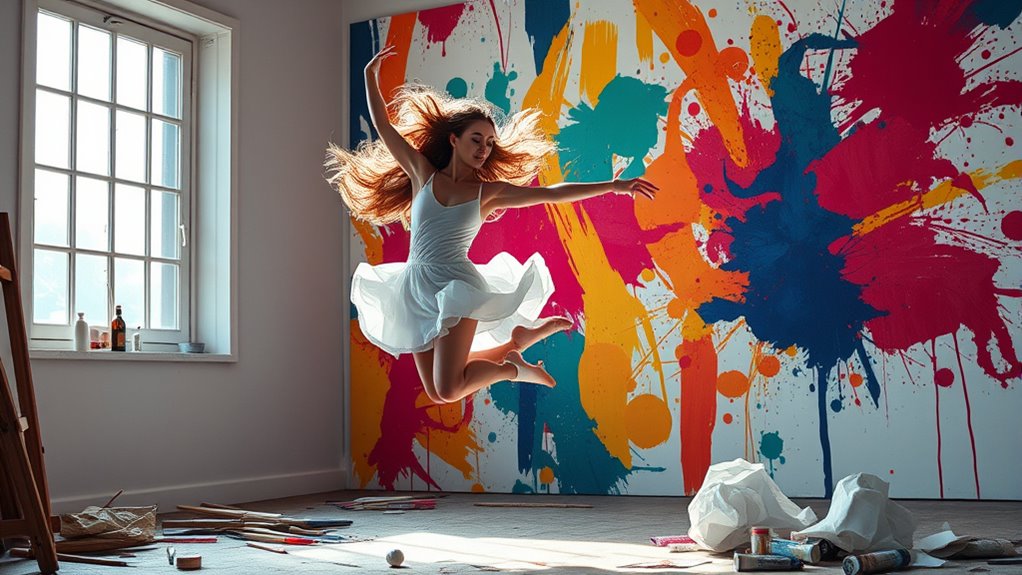
When you embrace uncertainty in your creative process, you open the door to spontaneous ideas and innovative solutions. This freedom allows you to break away from rigid structures and explore new avenues of expression. Additionally, curiosity contributes to overall life satisfaction and enhances your ability to generate creative ideas. By incorporating positive thinking practices, you can further nurture this creativity and resilience in your daily life. Engaging in mindfulness practices can also enhance your self-awareness and allow for greater spontaneity in your creative pursuits. Furthermore, adopting minimalism principles can help reduce distractions and create a clearer mental space for inspiration.
Embracing Uncertainty in Creativity
Although uncertainty can be intimidating, it’s the key to unblocking creativity and spontaneity. By embracing the unknown, you can let go of control and preconceived notions, allowing spontaneous ideas to flourish.
Here are some principles to guide you:
- Focus on the present moment
- Start anywhere to eliminate perfection pressure
- Use “yes, and” to encourage acceptance and risk-taking
- Transform mistakes into growth opportunities
- Tap into authentic expressions that resonate
Engaging in improvisation cultivates an environment where creativity thrives. Embracing risk-taking can further lead to innovative ideas and breakthroughs in your creative pursuits. Furthermore, creating emotional safety fosters an atmosphere where creativity can flourish, allowing you to explore and express your ideas freely. Additionally, practicing active listening can enhance collaboration and inspire fresh ideas during creative sessions.
When you fully embrace uncertainty, you’ll discover that unstructured moments often yield the most genuine performances. This journey not only enhances your creative output but also enriches your artistic expression, making it a rewarding experience.
Spontaneous Ideas and Innovation
Embracing spontaneity in your creative process can spark innovation and fresh ideas. When you allow yourself to engage in the present moment, you create a fertile ground for unexpected discoveries.
Starting anywhere in your improvisation encourages you to explore new concepts without the weight of prior refinement. This relaxed mindset reduces the pressure of evaluation, leading to innovative solutions in problem-solving situations.
As you engage in improvisational practices, you’ll likely find yourself entering a flow state, enhancing your creativity and connection with your environment. The freedom to embrace uncertainty opens pathways for fresh perspectives, transforming challenges into opportunities for exploration and innovation.
Building Empathy and Connection in Collaboration
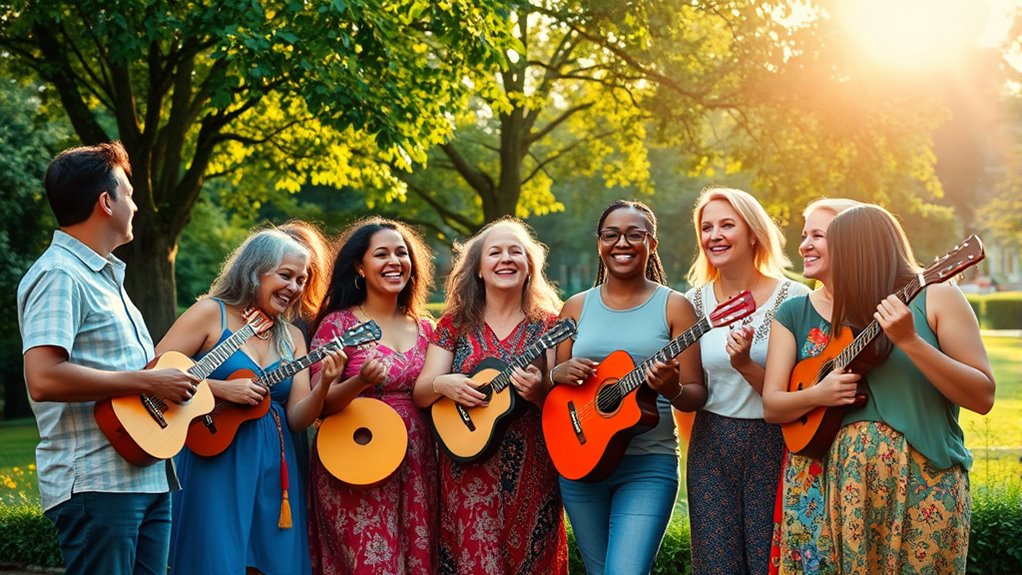
In collaboration, active listening is key to understanding your partners and responding to their cues.
By paying attention to non-verbal communication, you can create a safe space that encourages openness and trust.
This environment not only fosters empathy but also strengthens your connections with others as you work together.
Active Listening Practices
How can active listening transform your interactions in improvisation? By fully engaging with your scene partners, you create genuine connections and enhance the quality of your performances.
When you’re present in the moment, you avoid irrelevant offers and contribute meaningfully to the scene. Here are some key aspects of active listening:
- Validate others with “Yes, and” responses
- Foster empathy and understanding of different perspectives
- Enhance collaboration through mindful awareness
- Strengthen connections by acknowledging non-verbal cues
- Improve your social skills and improvisational flow
Non-Verbal Communication Cues
Active listening sets the stage for effective non-verbal communication, allowing improvisers to connect on a deeper level.
By honing your awareness of non-verbal communication cues like body language, facial expressions, and eye contact, you can respond intuitively to your scene partners. This practice fosters empathy, as you learn to interpret and react to their emotions and intentions.
Research shows that about 93% of communication effectiveness relies on these non-verbal elements, making them essential for building rapport in improvisation.
When you pay attention to these signals, you not only enhance your active listening skills but also create a more dynamic and engaging performance.
Ultimately, embracing non-verbal cues enriches the collaborative experience for both you and your audience.
Creating Safe Spaces
Creating safe spaces in improvisation isn’t just beneficial—it’s essential for fostering collaboration and creativity.
When you create an environment where participants feel comfortable expressing themselves, you reveal their potential and enhance the overall experience.
Here are some key aspects to reflect on:
- Encourage vulnerability: Embrace openness to allow creative risks.
- Practice empathy: Actively listen and engage with others’ ideas.
- Foster kindness: Build on each other’s contributions generously.
- Mitigate anxiety: Create a judgment-free zone to ease self-doubt.
- Establish trust: Cultivate respect to strengthen group dynamics.
Techniques for Letting Go and Engaging Fully
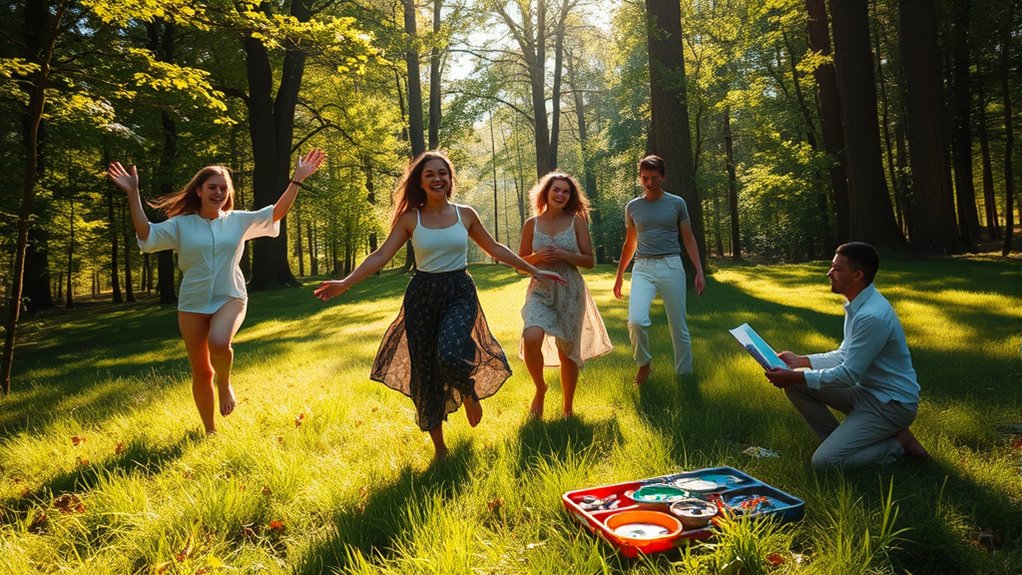
What techniques can help you let go and engage fully in the moment? Start with mindfulness practices like meditation and deep breathing to quiet your mind. This promotes present-moment focus, essential for improvisation.
Embrace spontaneity through “Yes, and” exercises, which foster acceptance and build on ideas without judgment. Try blind scenes, where you act without visual cues; this enhances your adaptability and quick thinking, allowing for genuine engagement.
Letting go of preconceived notions and mental clutter opens you up to new possibilities, boosting your creativity and authenticity.
The Transformative Benefits of Improvisation on Mental Health
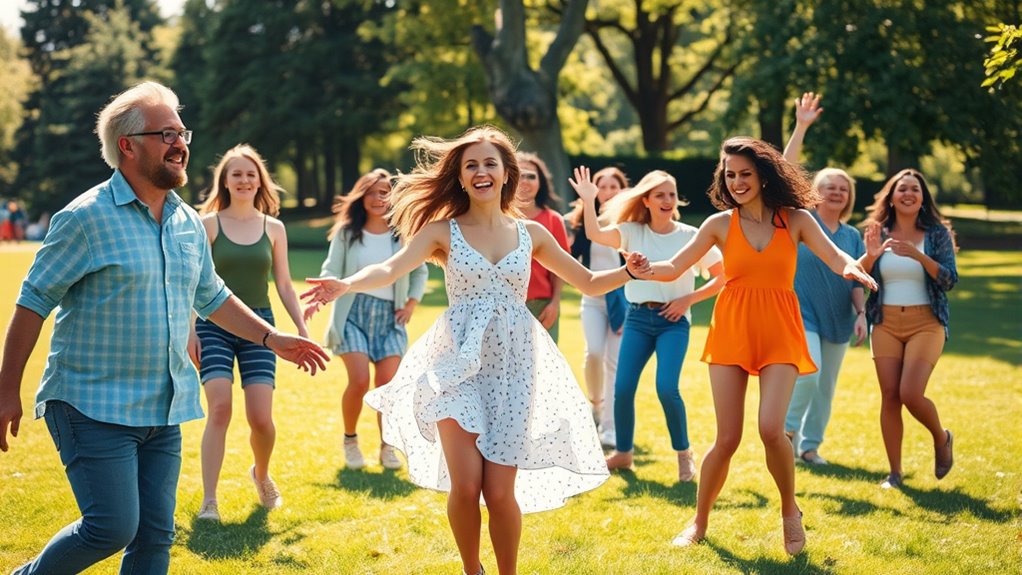
Improvisation not only sparks creativity but also offers profound benefits for mental health. Engaging in improv can help you let go of fear and embrace spontaneity, enhancing your overall well-being.
Improvisation ignites creativity while promoting mental health, encouraging spontaneity and enhancing overall well-being.
Here are some transformative benefits you can experience:
- Boosts self-esteem and confidence
- Reduces stress and anxiety levels
- Enhances emotional resilience towards failure
- Fosters strong social connections and empathy
- Releases creativity and facilitates personal growth
Frequently Asked Questions
What Is Spontaneity in Improvisation?
Spontaneity in improvisation means you’re creating dialogue, characters, and plots on the fly without a script.
It’s about embracing the unexpected, which fuels your creativity and flexibility. When you start anywhere, you contribute to a scene without the burden of perfection.
Letting go of preconceived ideas allows you to engage genuinely with your scene partners, leading to richer storytelling and authentic interactions that enhance your performance and personal growth.
What Are the Three Skills of Improvisation?
Improvisation’s three skills are like the gears of a well-oiled machine.
First, there’s active listening; you tune into your partners and surroundings, creating a rich narrative together.
Next, spontaneity invites you to let go of plans, embracing the unexpected with open arms.
Finally, adaptability guarantees you can shift gears smoothly when circumstances change.
Mastering these skills not only enhances your performance but also fosters a collaborative spirit, making every moment count.
What Is the Importance of Improvisation?
Improvisation’s important because it sharpens your quick thinking and adaptability, helping you tackle unexpected situations.
When you engage in improvisation, you reduce stress from rigid plans and learn to embrace spontaneity. This practice enhances your social skills and emotional intelligence, as it requires active listening and collaboration.
How to Do Improvisation Acting?
Improvisation acting’s like dancing without a choreographer; you’ve gotta trust your instincts.
Start by actively listening to your scene partners, soaking in their cues. Embrace the moment and let go of any fears that hold you back.
Adopt a “Yes, and” mindset—acknowledge their ideas and build on them.
Finally, practice mindfulness techniques like deep breathing to stay focused and calm, releasing your creativity and spontaneity on stage.
Conclusion
Incorporating mindfulness into improvisation not only enhances creativity but also strengthens your mental well-being. Studies show that engaging in improvisational activities can reduce anxiety by up to 40%. By embracing spontaneity and being present in the moment, you open up new avenues for expression and connection. So, whether you’re on stage or in everyday interactions, remember that the beauty of life lies in its unpredictability. Let go, engage fully, and watch how it transforms your experience.

